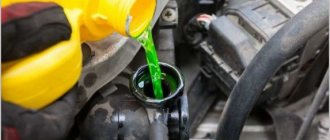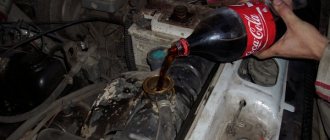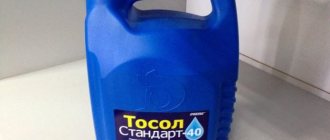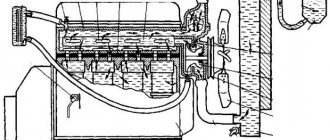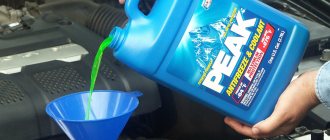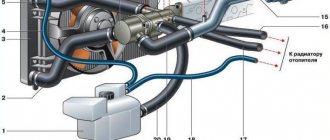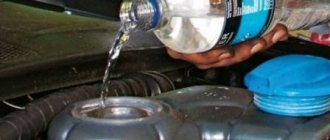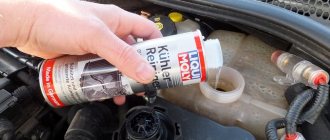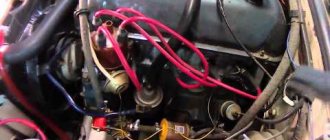Servicing a modern car is a rather complex task that includes many nuances. One of them is maintaining an optimal level of antifreeze. The efficiency of engine cooling will depend on this operation. Novice motorists often do not pay enough attention to this aspect. As a result, breakdowns may occur on the road, and the resource of the power unit is “burned out” unreasonably quickly. To prevent this from happening, you should figure out how often you need to add antifreeze to your car. But first, a little theory.
Why should you add coolant?
Antifreeze is the common name for special engine coolants. During operation, they circulate through a special circuit, which allows the generated heat to be removed. The heated antifreeze is transferred to the radiator, where it is rapidly cooled. If there is not enough process fluid or its quality is lost, then the temperature of the power unit will rapidly exceed the limit level. An overheated engine wears out quickly and may stall or even seize.
Why antifreeze
It would seem, why use special fluids if water can also cool the engine? In fact, buying antifreeze is a necessity. Water evaporates quickly and can freeze, and it also activates corrosion processes and forms scale deposits. Automotive coolant is made from ethylene glycol and water. The resulting solution of dihydric alcohol does not freeze even at low temperatures and practically does not boil away when heated strongly. In addition, antifreeze contains a complex composition of corrosion inhibitors that slow down and stop oxidation processes.
You may be interested in: How often to change antifreeze when you need to replace the coolant
Compound
The answer to the question of how to add antifreeze contains several points. In order for coolant to be added correctly, you need to take into account the characteristics of your car. If you decide that it is time to update the amount of refrigerant in the cooling system, you need to pay special attention to the composition. All antifreezes are divided into categories or classes:
G11.
These are traditional liquids based on ethylene glycol, water and silicate additives. They have a completely inorganic composition, so they can only be mixed with each other. For these antifreezes, manufacturers usually choose colors such as blue, green and sometimes yellow.
G12.
These are coolants that are called organic or carboxylate. Their base is also ethylene glycol, but compositions with carboxylic acid are used as additives. Such substances can be combined with the same or with antifreezes, the labeling of which contains advantages. Most often, such liquids are painted in warm colors: red, purple, pink and orange.
G12 (with pluses).
These are hybrid compositions that contain both silicate additives and organic additives based on carboxylic acid. They are suitable for mixing with other liquids from this category or with refrigerants of the G12 category. By color you can most often find bright yellow, lilac, purple and scarlet antifreezes of this class.
G13.
These substances are known as lobrids because they are significantly different from other refrigerants. The composition of coolant belonging to this category is based on propylene glycol. Therefore, such compositions can only be mixed with each other. They are painted in lilac, pink and purple colors, but sometimes you can also find yellow G13 class antifreeze.
MULTIFREEZE.
This liquid is a unique product that can be mixed with representatives of any class. Its composition is compatible with both traditional inorganic and carboxylate antifreezes. Multifreeze is also suitable for adding to hybrid and lobride liquids.
Is it possible to add incompatible compounds to the cooling system? No, this will damage the car. If you do not know what kind of antifreeze was poured into the car at the factory, it is better to drain the remaining amount. This must be done so that the new product does not enter into an unpredictable chemical reaction with it.
Is it possible to add water to antifreeze?
There are many disputes and opinions regarding the possibility of adding water to antifreeze. Let us take the liberty of saying that it is possible to add water to the coolant, but there are a couple of important points.
Antifreeze crystallization temperature
Firstly, the water must be distilled or at least well purified using filters. This is necessary so that the elements present in the liquid do not clog the engine cooling system and do not enter into a chemical reaction with the additives and additives present in the antifreeze.
Secondly, you can add very little water - 100.200 ml . Otherwise, it will greatly dilute the coolant, and the latter will lose its performance properties (critical in winter). Therefore, you can use water as a top-up liquid only in extreme cases, when the level in the system has dropped to a critical level, and you do not have similar antifreeze on hand.
Now let's look in more detail at the arguments that suggest that water can still be mixed with antifreeze:
- Water added to antifreeze will not impair its performance. Unlike coolants belonging to other classes listed above. This statement can be made on the basis that the properties of antifreeze largely depend on the volumetric ratios of the additives included in its composition. If they are violated (which happens when mixing “coolants” of different types), then the mentioned properties are reduced to “no”. Water proportionally reduces their volumetric quantity, that is, their ratio remains the same.
- Contrary to popular belief, adding water to antifreeze will lower the freezing point of the coolant. This statement can be made on the basis that the reduction in the volume of coolant in the system occurs mainly due to the evaporation of water. This process occurs when the safety valve on the expansion tank opens. Water evaporates first, and only then ethylene glycol. Accordingly, if you add water, the freezing temperature will be restored.
Frequency
How often do you add antifreeze and is it necessary to do so? It is impossible to give a definite answer to this question. It all depends on the following variable factors:
- type of coolant;
- refrigerant composition;
- additive compositions;
- car brand;
- features of vehicle operation.
it is important! Today, the market offers coolants made on the basis of silicate and carbosilicate. Original silicate antifreeze from a good manufacturer retains its quality for 3 years or 150 thousand km. Carbosilicate liquids can last up to 5 years or 250 thousand km. When deciding to add antifreeze to your car, you must first read the recommendations of the car manufacturer.
Features of the brand.
Some manufacturers, such as Volkswagen, Mazda and GM, claim that adding coolant is not required at all. Throughout its entire service life, the car will run on factory antifreeze. But in reality, it all depends on the operating conditions of the car and its mileage. Therefore, we recommend checking the antifreeze level at least every 5 years.
How often should antifreeze be added?
Car manufacturers give different service life of the coolant mixture. Topping up is carried out as the product is used, since the boiling point evaporates the water component. Maintain the level of antifreeze; there is no clear time frame for filling.
Unforeseen circumstances may occur that determine how often the procedure must be performed. Unnoticeable hose leaks, cracks in metal components of the car, radiator corrosion. If you frequently add antifreeze, inspect (the bright color of the mixture helps) the tightness of the system when the engine is hot, where pressure is created.
Step-by-step instruction
If you are going to add antifreeze for the first time, you probably have questions:
- to what level should it be added;
- where to fill the fluid, into the tank or radiator.
We have prepared step-by-step instructions with which you can independently add refrigerant to your car when it is cold:
1 step.
First you need to install the car correctly. For convenience, it is better to place it on a slope so that the hood is higher than the trunk. This will allow air pockets, if they have formed, to escape from the cooling system pipes. If you need to add just a little liquid, you can leave the machine in a horizontal position.
Step 2.
Carefully open the expansion tank cap. In case there is high pressure in the system, cover it with a rag. For added protection, wear gloves to prevent injury to your hands.
Step 3.
Smoothly and slowly pour antifreeze into the hole. This should be done in a thin stream and gradually. Its level should reach approximately 2/3 of the expansion tank.
Step 4
Start the engine and keep it running for about 5 minutes. This will allow the coolant to distribute throughout the system. If after this the amount of refrigerant in the tank has decreased, you can add a little more.
Step 5
Close the lid, wipe it, the neck and surfaces that have been splashed with antifreeze.
Topping up antifreeze in Kia Rio
A car of a Korean concern receives adding coolant to the expansion tank. Add antifreeze when the engine is cold; the fluid level should reach the Full mark.
- First, prepare the liquid in a clean container. Take one part of the distillate and the mixture (proportions recommended in the instructions for the Kia Rio). Select the proportions correctly for correct operation and protection of the cooling system.
- Remove the expansion tank cap without touching the hose going to the radiator. There is a tube in the tank, by pulling it out you can get the filler neck.
- We top up and return the hose to its place, close the plug on the neck, and turn on the engine. Detailed description in the photo.
How does operation affect
Abnormal engine operating conditions are a powerful factor in reducing the quality of the coolant. They may require topping up or completely replacing antifreeze. Typical negative factors include the following situations:
- prolonged operation of an overloaded vehicle;
- driving with low refrigerant levels;
- emergency topping up of unsuitable antifreeze;
- water entering the cooling system.
Consequently, the operating conditions of the vehicle also greatly influence how often antifreeze needs to be added.
Typical mistakes when adding coolant
It is necessary to replenish the refrigerant level in the system not only on time, but also correctly. In their manuals, car manufacturers describe in detail all the details of the procedure. There are always recommendations on the packaging of any antifreeze. But to many motorists the process itself seems simple, so no one delves into the technical documentation. So that you can avoid common mistakes, we have prepared a rating of them.
1. Constant rush
Automotive and coolant manufacturers emphasize in bold letters, warnings, and exclamation marks the strict need to add antifreeze to a “cold” system. At a minimum, the car should stand with the engine turned off for at least 10 minutes. What are the consequences of a violation? First of all, it is dangerous.
it is important! When adding cold liquid to hot liquid, a characteristic bubbling begins. As a result, the hasty motorist gets burns on his hands and greasy stains in the engine compartment. But there is also a technical aspect. The heated liquid occupies the maximum volume, so you will only need to add a little. As it cools, the antifreeze level will drop, but you won’t notice it.
2. Adding water
The chemical composition of automotive coolant is calculated based on the standard water content - approximately 5%. At this concentration, all anti-corrosion, anti-foam and other performance properties of the product are preserved. If you simply add water, then it is no longer possible to guarantee any properties of the entire liquid. Such actions often lead to freezing, which ultimately damages the line and radiator. Adding water is allowed only in emergency situations, when you need to raise the coolant level, but there is nowhere to get a suitable composition. Immediately after an abnormal dilution of antifreeze, you need to go to a service station to flush the system and fill it with good refrigerant.
3. Sudden movements
This error is also related to security issues. It lies in the fact that some motorists sharply unscrew the filler cap. If the machine has recently been operated, such actions may result in the release of a large volume of hot steam. To protect yourself from burns, you need to act carefully and slowly.
4. The details were mixed up
Some motorists, especially those who have never encountered the problem of adding antifreeze, want to add it directly to the radiator. This can only be done with some car models; for others it is better to use an expansion tank. If the radiator design of your car is collapsible, you can add coolant there. But this will make it more difficult to determine its level in the system and prevent the occurrence of air locks.
5. More is not better
There is no need to confuse antifreeze and engine oil. If the latter needs to be filled to the limit, then it is better to stop the coolant level in the middle of the expansion tank. If there is an excess of liquid, its thermal expansion will lead to increased pressure in the system. At best, this will result in a cracked tank, but you may also encounter ruptures in the system.
6. Matching by color
Adding antifreeze according to rules like “red to red” or “blue to blue” is a gross mistake. In fact, no one regulates the color schemes of manufacturers. The choice of coolant should be based on its chemical composition.
How to add refrigerant
Sometimes you just need to add coolant. In this case, it is extremely important to use coolant with the same composition, preferably from the same manufacturer. It is better to do this on a cold or slightly cooled engine. You need to open the system covers and then fill the radiator almost to capacity. If the coolant level was too low and air pockets formed in the system, you will need to let the engine run for a few minutes with the caps open to release excess pressure.
In the summer heat, distilled water can be added to antifreeze. It is not recommended to mix ordinary water, antifreeze or antifreeze with each other. If this could not be avoided, you will have to flush the system and fill in new coolant in the near future.
